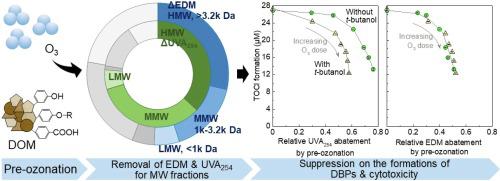Environment International ( IF 10.3 ) Pub Date : 2021-07-28 , DOI: 10.1016/j.envint.2021.106793 Wen-Long Wang 1 , Min-Yong Lee 2 , Ye Du 3 , Tian-Hui Zhou 1 , Zheng-Wei Yang 1 , Qian-Yuan Wu 1 , Hong-Ying Hu 4

|
Pre-ozonation can reduce the formation of disinfection byproducts (DBPs) and related adverse effects during subsequent chlorination, but the change of each molecular weight (MW) fraction during each step of combined pre-ozonation and post-chlorination has not been well illustrated. In this study, it was investigated in terms of electron-donating-moieties (EDMs) and UVA254 for a representative natural organic matter from Suwanee river (SRNOM). Pre-ozonation suppressed the post-chlorination of SRNOM through oxidation of almost all EDMs (>85%) and UVA254 (>90%) in high MW fractions (HMW, >3.2 kDa) and moderate EDMs (43%) and UVA254 (72%) in medium MW fractions (MMW, 1.0–3.2 kDa). Furthermore, pre-ozonation led to comparable abatements of EDMs and UVA254 for HMW fractions, but lower abatement of EDMs than UVA254 for MMW fractions. However, when t-BuOH was used as an •OH-quencher, pre-ozonation led to a few instances in which there were higher abatements of EDMs than UVA254 for the MMW fraction. These findings suggested that the HMW fraction dominantly underwent ring-cleavage of phenols via O3– or •OH-oxidation. Differently, the MMW fraction underwent ring-cleavage of phenols and quinones-formation via O3-oxidation, but occasionally underwent hydroxylation and hydro-phenol formation via •OH-oxidation. Because of forehand elimination of reactive moieties (e.g. EDMs), pre-ozonation obviously inhibited the formation of representative DBPs (67%–84% inhibition), total organic chloride (51% inhibition) and cytotoxicity (31% inhibition), but may have promoted the formation of carbonyl-DBPs (trichloroacetone and chloral hydrate). When compared with UVA254, EDMs would better for surrogate of DBPs formation. EDM abatement surrogated the formation of total organic chlorine (TOCl) and cytotoxicity following a two-stage phase, possibly because the speciation of DBPs and transformation products varied with the abatement of EDMs.
中文翻译:

了解预臭氧化对天然有机物后氯化过程中消毒副产物形成和细胞毒性的影响:紫外线吸收和分子量部分的给电子部分
预臭氧化可以减少后续氯化过程中消毒副产物 (DBP) 的形成和相关不利影响,但尚未很好地说明预臭氧化和后氯化过程中每个步骤中每个分子量 (MW) 分数的变化。在这项研究中,对来自苏瓦尼河 (SRNOM) 的代表性天然有机物质的电子供体部分 (EDM) 和 UVA 254进行了研究。预臭氧化通过氧化几乎所有 EDM (>85%) 和 UVA 254 (>90%) 的高 MW 级分 (HMW, >3.2 kDa) 和中等 EDM (43%) 和 UVA 254 来抑制 SRNOM 的后氯化(72%) 在中等 MW 级分 (MMW, 1.0–3.2 kDa)。此外,预臭氧化导致 EDM 和 UVA 的类似减少254用于 HMW 级分,但对 EDM 的减少比对 MMW 级分的UVA 254低。然而,当t- BuOH 用作• OH 猝灭剂时,预臭氧化导致一些情况下,对于 MMW 级分,EDM 的减少量高于 UVA 254。这些发现表明,HMW 部分主要通过 O 3 – 或• OH 氧化进行酚类的开环。不同地,酚类和醌类,形成经由澳MMW分数后行环裂解3 -氧化,但偶尔通过后行羟基化和加氢苯酚形成•OH-氧化。由于反应性部分(例如 EDMs)的正手消除,预臭氧化明显抑制了代表性 DBPs(67%–84% 抑制)、总有机氯化物(51% 抑制)和细胞毒性(31% 抑制)的形成,但可能有促进羰基-DBPs(三氯丙酮和水合氯醛)的形成。与 UVA 254相比,EDM 更适合作为 DBP 形成的替代物。EDM 减排替代了两阶段后总有机氯 (TOCl) 的形成和细胞毒性,这可能是因为 DBP 和转化产物的形态随 EDM 的减排而变化。









































 京公网安备 11010802027423号
京公网安备 11010802027423号